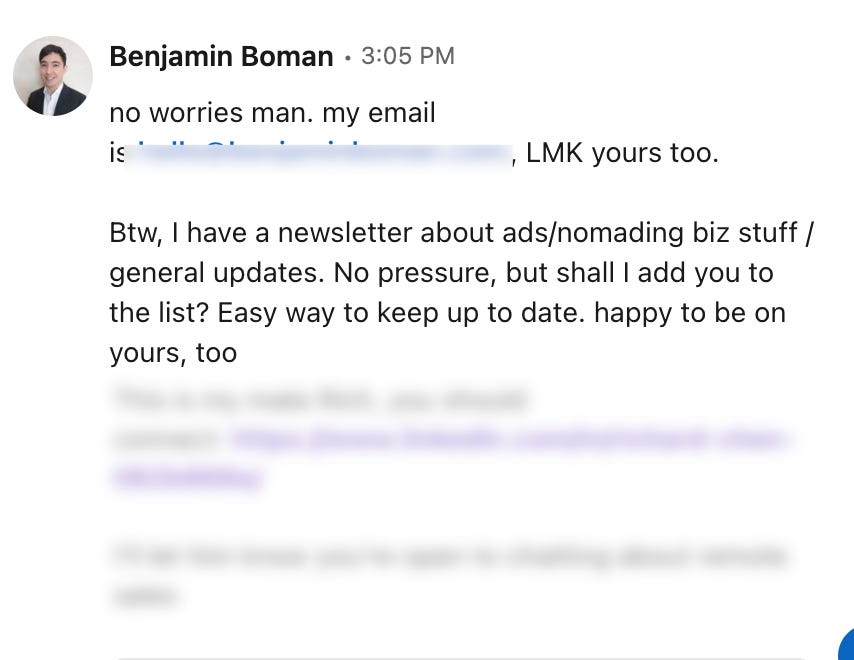How to Network Online: Naturally Find Clients, Develop Partnerships And Make Smart Friends
A slick-free guide to building helpful, genuine relationships online without spamming a business card or online events.
Networking online doesn’t have to feel awkward or blatantly transactional.
Over the years as a freelancer I’ve used a simple 5-step process to attract client referrals, build genuine relationships and develop allies who support my goals (and vice versa).
Many are surprised to hear that as much as 50% of my client work comes from my existing network. I’m the kind of introvert who limits calls per day and leaves events an hour or so after starting. But with the right approach, I find networking can feel easy and natural.
So here’s how you can do it too.
1. Focus On Friendships, Not Transactional Contacts
Imagine you’re only on a mission to make more professional friends.
I think most people imagine networking means things like going to speed networking events and getting business cards from boring people with bad breath and who talk too much.
It’s not like that.
To me, it’s a game where you’re trying to connect with smart, helpful, friendly people you’d enjoy having a coffee with now and then and catch up.
That’s the target.
I’m not saying shut yourself off to age groups or people with political affiliations you don’t tend to get along with (that would be too limiting). But keeping friendships as the focus will help you enjoy it, and make the whole process natural.
Start with this.
Think ‘Dream 100’
“Just make and maintain 2,500 contacts.”
A mentor of mine in university once taught me this as being core strategy of being a successful real estate agent for luxury and waterfront properties.
He calculated ~3% of people will move in a year and if these 2,500 people know, like and trust you, maybe 30-50% of those will ask you to sell their home. In Australia, assuming the commission to the real estate agent was $20,000 AUD, that’s $750,000 per year.
I know you’re likely not selling real estate, and don’t need that much business, but I think this strategy applies broadly.
Say you’re in a niche like as Meta ads management, too. It is true that a single digit % of people will need ads help themselves each year. And another % will know someone who does. This is the quantum of referral opportunity.
If I had to pick a number to aim for then 100 sounds like a good starting target.
2. Mine Your Followers Network First
Work with the connections you’ve already got.
It’s obviously easier to network with existing connections on LinkedIn, Twitter, Facebook etc even if you’ve never talked to them. You’ve probably had something in common at some point.
Yeah, that includes old school mates or former work colleagues.
You can literally open up your LinkedIn and scroll to the bottom of your contacts and start messaging or emailing people from there. Work your way up the list.
If you’re connected and actually don’t like that person just skip them.
What to message
So remember that part about making friends? How would you message someone you’re an old but not super close friend with after a long break?
This is the tone to aim for.
I usually share that I’m curious how they’re doing these days and would love to hear what they’re up to.
Depending on the warmness of their reply, you can suggest you guys catch up for a quick 15-30 minute coffee via Zoom chat to catch up properly.
Find a time, send a calendar invite, done.
What to say if you’ve never talked before
If you haven’t talked before, you’d change the message.
Give a genuine comment on something they look like they’re doing and suggest a 15 minute virtual coffee chat so that you can learn more about what they do, and potentially compare notes (if you have work in common to share intel on).
Why 15 minutes?
It’s a safe bet.
15 minutes is long enough that if you dislike each other, you don’t have to make an excuse to leave and it will be over soon. If it’s great then you’ll both leave feeling positively and that you’d like to talk again.
The first meetings are usually a little rough anyway. You’re just starting your connection.
3. Make Every Virtual Coffee Chat Count
To open a call is easy.
Share again why you’re reaching out, which is probably that you noticed you two have something in common, or they’re up to something interesting, and that you wanted to catch up or learn more about what they’re up to now.
Most people will continue the conversation from there.
Ask about them
Find out what they’re doing. How does that work? What do they like and not like? What projects are they dreaming of?
Firstly, this gives you an opportunity to help them if appropriate. Which in itself is good networking.
It also leads them naturally to ask your side of the story. Most socially aware people will ask about your work, goals, and challenges.
Now you can explain what you’re doing and what you’re working on.
If they’re interested in a product or service you provide (prospective clients) they’ll ask more about it.
If they think you can help someone (referral opportunity) they’ll ask more or ask if you can help their colleague.
If you have a problem that they’d like to help you with, they’ll offer it.
No pitches and no begging required.
And if they don’t care about your product or service then they probably won’t ask about it at all. Don’t force the topic.
Avoid making big asks to new people
I think it goes without saying, but if you don’t really know someone yet - avoid making any big asks on the call. You haven’t developed any connection capital yet. That comes later if the business relationship develops more.
But you can still ask for very small, gentle lifts. E.g. information about something or for any introductions to people they think appropriate.
Don’t rush to help them either
Of course, you want to help the people you’re chatting with.
But if you push too hard it can come across as very forced on a new networking call. People will get that feeling you have an urge to ‘scratch their back’ just so that you can get something in return.
Be cool.
Ask first if they’re interested in your opinion about a problem or if they’re open to an introduction to someone you know before offering.
Ending a call
Most calls end around the time allocated.
If they aren’t wrapping up the call by themselves, an easy conversation winding-down topic is asking them their plans for the year/quarter. You can also gently add in the conversation a reminder that you value their time, know that they have other things to do, and suggest that you two might need to let them go.
(At least, that’s what I do 😬).
Thank them for making the time and suggest you two keep in touch.
At this point, if you two get along super well then you can also suggest to catch up in say 3-6 months to hear more about {something that came up in the conversation}. That will naturally set your next conversation to deepen the relationship.
Don’t forget to take notes
These can be on paper, email trial, Notion or other tools.
You need to remember what you last talked about somehow. It’s embarrassing not to know somebody has just had a kid or is suffering an unfortunate life event when you reach out time and end up looking like a total arse.
I sometimes use Notion to do a quick recap, date we caught up, when we should probably next catch up.
4. Maintain & Develop Your Network
Most of the benefits of your network come drip by drip over time as you support and make stronger connections over time.
So you’ll need to keep in touch.
But that doesn’t always mean having another call.
Sure, if you vibe with someone, you can keep catching up on calls with them as much as you like. If they’re an older generation, you can even *gasp* call them. Unannounced! Though I suggest reaching out at least once a year to keep the connection alive.
For others, you can keep in touch in other, really low-touch ways.
You can:
Like or share their posts on social platforms.
Comment on their articles and videos.
Share them awesome articles you know they’ll love (it has to be great stuff, and don’t do it more than once every now and then).
Send an email, at least once a year. Birthdays, New Years, etc are easy occasions.
Buy their products and send them what you think, or leave reviews.
I even ask people if they’re OK for me to add them to my email newsletter as an easy way to keep in touch and for me to share what’s going on. They’ve only said yes.
5. Grow Strategically
At some point, you may finish these lists and start looking for new people.
My suggestion here is to be targeted.
I’ve found it effective to network with people that I can still probably be friends with but who have a stronger, natural cross over with my work. E.g. freelancers, personal brands, agency owners, etc. People who I might want to collaborate with, or likely be able to refer business between each other.
Obviously you can also network with anyone you think you’ll get along with.
But based on this - will networking be a thing you try in 2025? Why or why not?







Interesting! I don't have such structured systems for networking and keeping in contact, I mostly just DM them on Substack 😂 But these all make sense, thank's for sharing!